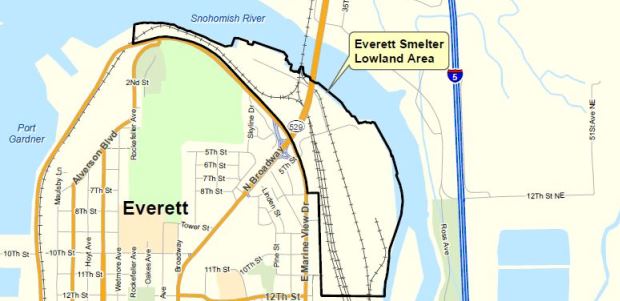
Everett Smelter Lowlands Cleanup Proposed
The Washington State Department of Ecology's public comment period is open through Sept. 20.
The Washington State Department of Ecology's proposed cleanup plan for the Lowlands area of the Everett Smelter site has been released for public review and comments. Lowlands lies along the Snohomish River.
Ecology seeks public comments on the draft plan for Lowlands and related materials through Sept. 20, 2016, and will review all comments before finalizing the plan.
The Everett Smelter, built by Puget Sound Reduction Company, operated from 1894 to 1912. ASARCO Inc. bought the property in 1903 and operated the smelter until 1912, when it was demolished; the property was sold in various parcels and homes were built on many of them. A highway interchange between East Marine View Drive and State Route 529 was built across the old smelter site in the 1950s. The site includes the industrial area along the Snohomish River, and the site is divided into the Uplands Area and the Lowlands Area, with Uplands being used for residential, light commercial, and recreational purposes, while Lowlands Area is for industrial use. Ecology discovered the contamination in 1990 and began working with Asarco to investigate and clean up the site. A cleanup plan for Uplands was finalized in 1999.
Asarco declared bankruptcy in 2005. Ecology, which filed a claim in bankruptcy court for Asarco’s environmental liability for the Everett Smelter site and other sites in Washington state, has worked with the Everett Housing Authority to clean up the part of the smelter site with the highest levels of contamination, but cleanup stopped in 2007 due to lack of funding. In December 2009, Ecology received a bankruptcy settlement of $188 million from Grupo Mexico, a large Mexican mining company that brought Asarco out of bankruptcy, and $44 million of the settlement was set aside for the smelter site cleanup.
The list of metals that has been investigated related to former smelter operations includes arsenic, lead, cadmium, mercury, thallium, antimony, zinc, and copper. Arsenic is the primary contaminant of concern resulting from the smelter's operations.
The cleanup plan covers 15 locations within Lowlands, which comprises 230 acres between East Marine View Drive and the riverbank. Ecology drew from two reports – the Supplemental Remedial Investigation and a Feasibility Study – to select the cleanup technologies. More than one technology will be used at some of the locations:
- Removal of contaminated material at two locations by excavation to be treated or disposed of at an approved facility
- Capping contaminated soil at six locations to prevent the spread of pollutants by blocking stormwater from entering contaminated soil
- On-site treatment at one location, where chemicals injected into the groundwater will combine with the arsenic and prevent it from migrating to the river
- Property use restrictions at two locations, where contaminated soil should be left undisturbed, including fencing, permit requirements, and zoning regulations that will prevent people's exposure to soil
- Drain pipe repair or removal at one location to prevent potential contamination from entering the river
- Monitored natural attenuation, to be used at five locations, will use water sampling to confirm that contaminants are breaking down through natural processes.
All sites will be monitored after their cleanup actions to confirm that the cleanup remains effective, the agency reported Aug. 22.
The Uplands portion of the site is about 215 acres; Uplands residential and park cleanups are complete, under way, or in planning.
Ecology seeks comment on two other items, the public participation plan and the State Environmental Policy Act checklist and Determination of Non-significance.
Written comments may be sent to Sandra Matthews, site manager, at sandra.matthews@ecy.wa.gov or Department of Ecology, 3190 160th Ave. SE, Bellevue WA 98008.